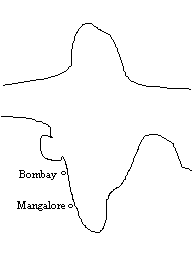At some time or other in one’s life, walking down memory lane, one begins to wonder about the roots of their existence but invariably is disappointed to find that the people who could have told them about these things have all departed from this earth! Some of us do not care about the past, but there are a few who do care, as ultimately what we are depends on our past history, as we carry the genes and characteristics of our ancestors.
Many have tried telling the story of their lives and of their families. I attempt to tell you my story with the hope that it would give you an insight and appreciation of our roots and provide a clearer picture of events that have taken place in the past.
India, our Mother Land
|
|
India is often pictured in the form of a lady dressed in a sari, with her legs crossed at her ankles. In this picture, Bombay her Financial City seems to be dangling from her left hip, as if it is her bunch of keys. Goa strides along her thigh between Bombay and Mangalore. Mangalore, like a small jewel decorates her left knee, as the Arabian Sea on its West Coast bathes it. In physical terms the distance between the two coastal towns is quite large. An 18 hours bus ride going southwards from Bombay takes you first to Goa.
Goa
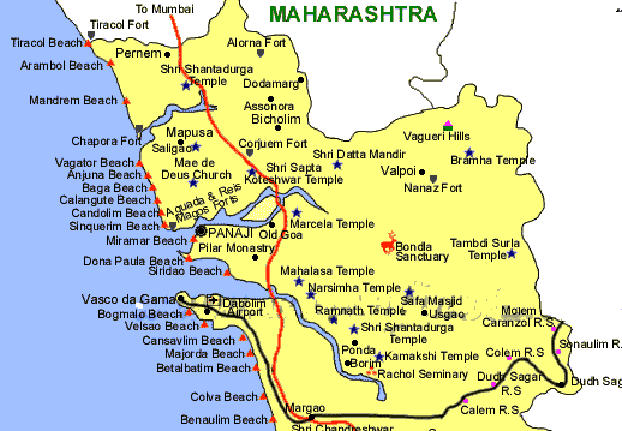
Graphic: North Goa
Some four hundred and fifty years ago, the Portuguese had come to trade with India, with their great and famous explorer Vasco Da Gama. After showing their credentials at the Court of Akbar the Great, the Portuguese purchased Goa from the Nawab of Bijapur and made it their Eastern Head Quarters.
Panjim, the capital of Goa, was known as ‘Ponjem’ in olden days and many Konkani songs called Mandos celebrate the name. The Portuguese folk songs were called Fado, (pronounced ‘faad’ (and the Konkani name for songs, Pod might be a corruption of the Portuguese word.
As the trade developed, the Portuguese founded trading centers on the west coast, and among such centers was one at Coondapur Catholic missionaries came and settled in Coondapur, and the Portuguese built many churches, and their influence has lasted till today. Many of these Portuguese might have inter-married with local people, and that could be an indication, why many of the Catholics in the north are fair, with light eyes. Many Goans migrated to Coondapur, to work in these settlements. The boats, which used to sail on the coast, were called ‘Patmars’. Perhaps the name might have had something to do with Bat' de Mar, meaning ship of the sea. In those days the sea-wind powered the boats with the help of sails. On some such Patmar the Portuguese and the Goans might have sailed to South Kanara. My maternal great grandfather, Christopher Castelino owned three such Patmars, which went down on a fateful stormy night in a raging cyclone. He ended up in bankruptcy, as in those days there was no insurance cover for sailing vessels.
Mangalore
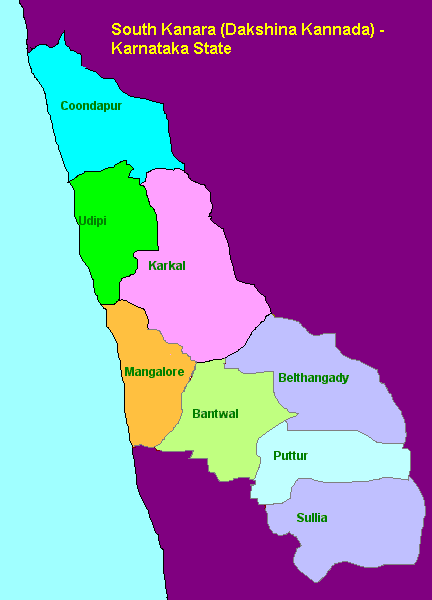
Graphic: South Kanara District
During the time of the Mogul rule, Mangalore a small town on the West Coast of India was ruled by a Hindu king. Perhaps he was the King of Bednore. It gets its name from the Kannada words “Magala Uru” which means The Daughter’s town. Some say, that the king had two daughters and he gave this town as a gift to his elder daughter. There was also another town called Chikamangalore, in the Coorg district nestling in the Western Ghats with its verdant coffee estates. It was known for its famous warriors, the ‘Kodagas’ who have always been a part of the Indian Armed Forces. Chikka in Kannada means young or small and the town might have been given to the younger daughter. In the course of history, Mangalore came under the rule of Hyder Ali, the father of Tippu Sultan. After the defeat of the latter by the British, it was incorporated into the British Raj, as part of the Madras Presidency.
Coondapur
In the days of the Madras Presidency South Kanara, the 26th district was divided into six talukas, and the northern most one was named Coondapur where the Portuguese had a trading post. With its rivulets, backwater creeks, and villages full of coconut trees, this is regarded as a very beautiful part in South Kanara, Towns like Karwar, Belgaum to its north, were part of North Kanara.
Catholics of the western coast speak Konkani, in different dialects. In Maharashtra, Marathi, the language spoken by the people, is very similar to Konkani, in Ratnagiri; the language turns to Konkani. Down to its south in Goa it takes the shape of the Goan dialect, and as we go further southwards to Karwar the shade of the language changes, and finally in South Kanara we get the Mangalorean dialect. Even in South Kanara, the nuances of the spoken language vary from village to village. Konkani does not have its own writing script. Ratnagiri area uses Devanagiri script. Goa used the Roman script under the Portuguese and in South Kanara the language was written in Kannada script.
Thus from Ratnagiri to Mangalore , the coast is called the Konkan Coast. The Railway, which runs along the coast, is also named after it: The Konkan Railway.
On a hill far away.....
On a quiet hill in Goa, called Mont de Guirrem, the Capuchins have their Monastery. Fr. Joseph, my elder cousin, who was a Capuchin friar who served in this monastery, told me that on one side of their monastery the landowners lived, and one among them was one Pais family. On the other side of the road lived the people who tilled the fields for the land owning families. It is said, that there was a custom, perhaps handed down by the Portuguese rulers, that during the rite of baptism, the baptized took the surname of their God-fathers. The landowners and the tillers had the same surnames, as the God-fathers of the landowners were some of the Portuguese people, and those of the tillers, were the Landowners who gave their surnames to the Indian converts. Before conversion, their family names were Prabhu, Kamat, Naik, Pai etc. The Pais household was a Prabhu family before their conversion to Catholicism. Pais in Portuguese means ‘Country’.
My story starts with a family, headed by a person named Cojma, Portuguese version of Cosmos. Nothing is known about him, except that my cousin, Fr. Joseph o. f. m. Cap, culled his name out of the birth and death registers of the Mont de Guirrem monastery. He was preparing data for his father, Marian Salvadore Pais, who wanted to prepare the Pais Genealogy. Cojma (Cosmos) might have had many children, but two of his sons, Salu, and Domingo, decided to move out to Mangalore. There might have been a teary send off, with their mother packing pickles, dry fish and masalas for their use in Mangalore, and some food for the voyage on the Patmar. They might have sailed from the Marmagoa Harbor, with many other Goan men, who might have had surnames like D’Souza, Fernandes, Gonsalves, Tellis, Saldana, Castelino, Sequeira etc.
Pais Brothers - Salu and Domingo
Salu
The place where these two brothers lived in Mangalore is not known, but I thought they might have landed in Coondapur ; While many of their friends remained there, others might have gone southwards looking for jobs or to start some business of their own. They may have settled in different villages and towns.
Salu, the older boy of Cojma, might have got married first, probably to a girl from a Shetty family in Mangalore, as her name is recorded in the genealogy, as Zoblu Shet. Domingo married later and his wife’s name is not recorded anywhere.
Probably, Salu was able to own some land with the help of his father in law. From the name Zoblu, his wife might have embraced Catholicism, the religion of her husband, or she might have been the daughter of some convert, who did not change his surname.
Salu and Zoblu might have been a very loving couple, as they had nine children. The eldest was a girl called Anna whom they got married to one Morian Coelho, who might have been the son of a man who had traveled with the father from Goa. Jackie , was born after Anna and as a boy must have worked on the land, helping his father tilling it, and looking after the farm animals. He had four younger brothers, Pascu, Juze Mingel, John, and Simon.
The sisters too were younger to Jackie were Modthes, (Martha) who married Kaithan Gosal (Gonsalves). Modthes was the girl in between Pascu and Juze Mingel . The latter married Anna Costa, while the former might have died unmarried.
Domingo Pais and his family
Domingo the brother of Salu had eight children, four boys, and four girls. The boys were Niku, (Nicholas) who married Regina Mathias. Juze was married to Mercy Rego. Intru (a rare name) married Mercy Soz, and Anthony who might have died young or remained a bachelor. Since Domingo was the first generation Goan to have migrated to Mangalore whether the marriages of his children took place in Goa or Mangalore is a matter left to conjecture The famous lawyer, Mr. L. C. Pais and Mona Pais of M. Pais and Sons are his descendants.
The children of these couples were marrying their second and third cousins. Thus my mother was the daughter of a Tellis girl but since no one thought of genealogies in those days her story is not kept alive. Perhaps it is time, that our children kept their diaries, and wrote down their memoirs so that one-day their children could use them.
Anton and Seraphine
Anton and Seraphine, descendants of Salu Pais, were the paternal grandparents of my father, John Pais. Anton's grandfather sustained himself and his family from the fruits of the land, which he owned. He also had farm animals, and used to supply milk to his community around him. I think Anton moved to Mangalore proper and lived somewhere close to Light House Hill.
Juze, my grandfather was born around 1860. He became a renowned coffee planter of Mangalore and became a prominent benefactor of many institutions of Mangalore like the Milagres Church, Fr. Muller's Hospital etc. He build a house in Balmatta, where my father was born. It was sold in 1934 due to a financial crisis in the family after my grand father's death. It was eventually bought by the Sisters of the Nazareth Convent and kept the living room as their chapel. My mother lived in this house again before her death, in the home run by the sisters. My brother said Mass in this chapel and it has left fond memories in our minds. Our elders used to sing the Old Kentucky Home tune by replacing Balmatta for Kentucky.
The latter part of the history of the Pais family will show that many families were tied to each other by way of marriage right up to the twentieth century. From the second half of the twentieth century, the children started to choose their spouses and many inter faith and inter community marriages took place. The families were no more bound by the land, as the Indian government had passed a new law ‘land to the tiller’ as an agrarian reform, which broke the hold of large land owners.
My Paternal Grandparents
I share this story with you, not out of vanity, but believing that you too may identify yourselves, as to how our ancestry has affected the way we think and act.
Family Photo of my Father's Family taken in 1929
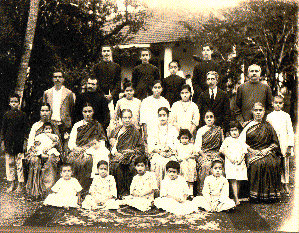
John, my father, was born in Mangalore on 14th May, 1890 to Juze Pais and Regina Saldana, in their home in Balmatta, which has now become a Convent of the Nazareth Sisters.
My paternal grandfather Joseph Pais (Juze Pais) a well-known coffee planter in his day was born to Anton Pais and Seraphine Tellis, on 18th May 1860. He married Regina Saldana, on his 20th birthday, on 18th May 1880. He built his coffee plantations from scratch, with his close friend Saturnine Mathias, his distant cousin. They walked fifty to sixty miles, “hitch-hiking with bullock carts, plucking and eating tender coconuts from wayside coconut trees, and living on beaten rice”, as told to me by my elder cousin. During his time, he was one of the richest men in Mangalore, and was a great and generous benefactor of many Catholic institutions, like schools, churches, and hospitals. In fact, his name appears on the top of the list on the marble slab, on the left side verandah wall of the Milagres Church. He was also the first benefactor of the Kankanady Fr. Muller’s Hospital .
After his death on 23 August 1925, my paternal grandfather was buried in the old Milagres church, before the present structure was constructed. In the present church his grave is under the Sacred Heart altar on the right side of the main church. My paternal grandmother, Regina Pais died around 1930 and was buried on the left side verandah of the Church.
On the inside surface of the outer wall of the left verandah, there is a marble slab of benefactors, who contributed to build the new church. The first name is of our grandfather, Joseph Pais. The church is dedicated to Our Lady of Miracles. Miracles or Milagres is pronounced as Milar, in Portuguese.
My Maternal Grandparents
Family Photo of my Mother's Family taken in 1932
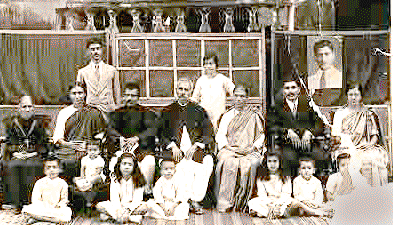
Hampankatta -
Hampankatta, the commercial center of Mangalore , is not far from the sea on its west. I was born to Stella Mary and John Pais in 1934 on the upper floor of the Catholic Bank building, which also housed its first Secretary who was my maternal grandfather, Mr. John Manuel Castelino. The Milagres Church, built some 450 years ago, was situated in this locality
My maternal grandmother’s sister, Francesca was married to Anacletus Coelho , the maternal grandfather of my wife, Leola. In consideration of the age of his young children, after the death of his first wife, Mr. Coelho married Lily Pinto, whose eldest daughter Anne was married to Vincent Aloysius Wade in 1939 and their eldest daughter Leola, (my wife) born in 1940. .
My mother, Stella Mary, the eldest daughter of John Manuel Castelino and Felicitas Tellis, was born on 1 October 1902 in Milagres. My maternal grandfather retired as the head master of Milagres School after serving it for fifty years. Many leading luminaries of Mangalore studied under him. He was well respected by his peers for his intellectual abilities, and was instrumental in founding the first bank in Mangalore that was run by Catholics, the Catholic Bank. He also helped in founding other institutions like the Catholic Club and the Catholic Provident Fund Bank. The Catholic Bank merged with the Syndicate Bank in the 1950s after management goof-ups.
Mr. Irenaeus Lobo was the colleague of my grand father who, once told us about his ability to take all sorts of challenges. Mr. Lobo was a teacher in the school, and all the teachers decided to challenge my grandfather. They used to call him “Mistry” which meant Master. They said to him, “Mistry, you can do many things, but we are afraid you will not be able to stitch your coat". In answer, he told them to bring the cloth and when it was provided, he put it on the table, and started to rip his old coat, so that he could place the pieces on the new cloth and start cutting. When the teachers saw this, they gave up, in deference to my grandfather and were astonished at his mind.
Both my maternal grand parents were buried in the Cemetery behind the Milagres Church. My grandmother: Felicitas Tellis-Castelino, died on 31st December 1934, two weeks after my birth and my grandfather John Manuel Castelino died on 26th September 1945.
We used to call our maternal grandfather “Abu” and my maternal grandmother: “Filsu Mai".
My paternal grandfather was "Vodlo Aan" and my paternal grandmother was “Vokkle Mai". Vokkle was the word for spectacles, and she used to wear them
In spite of turmoil in the world far away, in the early part of the 20th century, India remained unaffected, as we were not directly involved or invest in the war. It is our rulers, the British who ultimately paid the price, and got out of our country in 1947.
Mother was 16 years old, and was going to school. She was a large bodied girl, and tall for her age. The Nuns put her in the last row in her class. She used to eat a whole half kilo of beef for her meals. This initial nourishment helped her to last to all sorts of ordeals in her later life.
Abu’s houses
At the time of my birth in 1934, my grandfather lived in the Catholic Bank quarters, on the left side of the compound in front of the Milagres Church. (This has been demolished for town planning). The Catholic Bank moved to new premises in the 40s on the Light House hill road. He moved to a house in the Coelho lane in the late 30s. This area is known as Falneer. It was a beautiful house with gothic style windows and glazed floor tiles As usual there was a portico at the entrance. There was a shower in the bathroom, and we used to be taken often there in summer when there was no water in our well in Jeppu. A fascinating stream on the right side of the house flowed under a small bridge. We could see fish swimming in it in the clear running water. I used to often stand on the bridge on my way to the school, and watch the wriggling fish with great admiration.
Clothing and Culture
I have told my personal story, so that you will realize how life was during the early part of the 20th century, and how our elders lived and dressed. They were conservative, but abreast of what was happening in the world. My father's brother -in-law was a deputy Collector. They excelled in education and supported the institutions of Mangalore in whatever way they could The generation that followed, reaped the fruits of their endeavors.
| < Prev | Next > |
|---|







